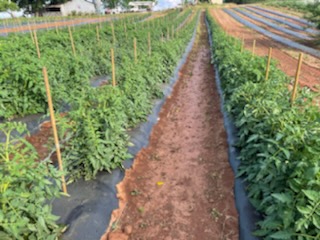All images are from @methodofmad.
I traveled across the widest part of Georgia, USA recently, and right through the heart of agriculture. Georgia is known as the Peach State, but produces a variety of crops like peanuts, pecans, produce (vegetables), cotton, and corn.
I meandered through the town of Fort Valley and weaved my way through Peach County, GA.
 peach trees blossoming in Georgia
There were rows and rows of peach trees and the next orchard was rows and rows of mature pecan trees. Then, I saw a unique format of peach trees with alternate rows of young pecan trees. Pecan trees need 7 to 10 years to begin producing nuts, so the farmer had alternated his rows so there would be peach production while the pecan trees were maturing. As the years pass, the pecan trees will shade out the peach trees, but by that time the peach trees will be near the end of their production cycle.
Increasing food production is very important. In the next 30 years, the world population will reach 10 billion people. Between now and 2050, food production needs to increase by 70 percent. Some countries are already moving to indoor production.
I was surprised to see in Peach County a large glass greenhouse complex. Pure Flavor has a 75 acre facility that grows vegetables indoors. All around the facility are old school peach, pecan and crop row farmers. Indoor production has some advantages over outdoor production.
According to the University of Georgia Extension, farmers in Georgia will need to spend an additional $328 to $494 per acre on chemicals, pesticides and fertilizers this year, than last year for many outdoor row crops. That 29 percent increase in production cost will be difficult since margins are tight for farmers.
peach trees blossoming in Georgia
There were rows and rows of peach trees and the next orchard was rows and rows of mature pecan trees. Then, I saw a unique format of peach trees with alternate rows of young pecan trees. Pecan trees need 7 to 10 years to begin producing nuts, so the farmer had alternated his rows so there would be peach production while the pecan trees were maturing. As the years pass, the pecan trees will shade out the peach trees, but by that time the peach trees will be near the end of their production cycle.
Increasing food production is very important. In the next 30 years, the world population will reach 10 billion people. Between now and 2050, food production needs to increase by 70 percent. Some countries are already moving to indoor production.
I was surprised to see in Peach County a large glass greenhouse complex. Pure Flavor has a 75 acre facility that grows vegetables indoors. All around the facility are old school peach, pecan and crop row farmers. Indoor production has some advantages over outdoor production.
According to the University of Georgia Extension, farmers in Georgia will need to spend an additional $328 to $494 per acre on chemicals, pesticides and fertilizers this year, than last year for many outdoor row crops. That 29 percent increase in production cost will be difficult since margins are tight for farmers.
 harrowing, tilling soil and adding herbicide
As the demand for food increases worldwide, farmers are also encountering pressure from environmentalist to reduce pesticides, conserve waters, and farm sustainably.
As farming has changed, so has the ability to feed people. In 1940, a single farmer produced enough food for 19 people. Today, a single farmer produces enough food for 155 people. But that growth in production is a result of mechanization (industrial equipment versus human labor), chemical consumption (pesticides, fertilizers), and gene modification of seeds and plants. The cost to farm is called an input, and the food produced is called an output. While input of human labor has declined significantly, inputs of chemical, fertilizer and modified seed may have negative environmental impact.
Indoor facilities offer potential to reduce the input cost of chemicals, water consumption and loss of crop to weather conditions. Indoor greenhouse facilities use hydroponics and aeroponics. In addition, the amount of land needed is less. However, there are some negatives. Greenhouses consume energy for production, especially when facilities are used year round. Plants need artificial light and heat in winter. The initial cost of a facility is more than many farmers can afford. Which means production is concentrated among fewer corporate-owned farmers. In some rural areas and countries, utilities are not reliable enough for greenhouse production.
harrowing, tilling soil and adding herbicide
As the demand for food increases worldwide, farmers are also encountering pressure from environmentalist to reduce pesticides, conserve waters, and farm sustainably.
As farming has changed, so has the ability to feed people. In 1940, a single farmer produced enough food for 19 people. Today, a single farmer produces enough food for 155 people. But that growth in production is a result of mechanization (industrial equipment versus human labor), chemical consumption (pesticides, fertilizers), and gene modification of seeds and plants. The cost to farm is called an input, and the food produced is called an output. While input of human labor has declined significantly, inputs of chemical, fertilizer and modified seed may have negative environmental impact.
Indoor facilities offer potential to reduce the input cost of chemicals, water consumption and loss of crop to weather conditions. Indoor greenhouse facilities use hydroponics and aeroponics. In addition, the amount of land needed is less. However, there are some negatives. Greenhouses consume energy for production, especially when facilities are used year round. Plants need artificial light and heat in winter. The initial cost of a facility is more than many farmers can afford. Which means production is concentrated among fewer corporate-owned farmers. In some rural areas and countries, utilities are not reliable enough for greenhouse production.
 tomatoes as row crops
I clipped my Spring Vegetable Planting chart and put it on my refrigerator this week. Soon, I will prep my raised beds and then take some favorite seeds from the freezer. I will grow a variety of vegetables, all organically. But I know not everyone has the time, land or money for small scale farming. We are a big world with big population growth. How we farm in the next 30 years will determine if there is enough for everyone.
*statistics for this article are from Georgia Department of Agriculture, Farmers & Consumers Market Bulletin Vol. 104, No 25
tomatoes as row crops
I clipped my Spring Vegetable Planting chart and put it on my refrigerator this week. Soon, I will prep my raised beds and then take some favorite seeds from the freezer. I will grow a variety of vegetables, all organically. But I know not everyone has the time, land or money for small scale farming. We are a big world with big population growth. How we farm in the next 30 years will determine if there is enough for everyone.
*statistics for this article are from Georgia Department of Agriculture, Farmers & Consumers Market Bulletin Vol. 104, No 25